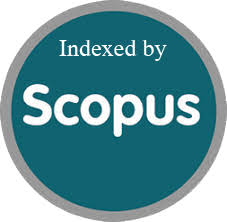Wetting Pattern for A Two-Line Trickle Source
Abstract
The laboratory tests carried out 12 tests to follow the advance of wetting front at appropriate times during the wetting and redistribution phases as a resulting of water application from a single linear trickle source or two linear trickle sources with a certain spacing to soil profile. These data are used to express with an estimating relationships for the wetting pattern produced by single linear trickle source and two linear trickle sources during wetting and redistribution phases. The study showed that there is a significant correspond between the wetting pattern of the measured and the estimated by the experimental equations. The wetting pattern increases with the decreasing of spacing between the two linear trickle sources, and this increase is regular along the wetting front or the surrounding of the wetting pattern, and this increase in the vertical direction of the wetting pattern is more in sandy loam soil than in silty clay soil and vice versa in the horizontal direction, when compare among the wetting patterns at the end of the wetting phase and the redistribution phase at a total time of 72 hours.
References
- .5 (2011) " ". (18)(2).
- Hammami,M.,H.Daghari, J. Balti, and M.Maalej (2002) Approach for predicting the wetting front depth beneath a surface point source: Theory and numerical aspect .Irrigation and Drainage (51) : 347-360. (www.interscience .wiley.com).
- Lazarovitch, N., A.W.Warrick. A.Furman, and J.Simunek (2007) Subsur-face water distribution from drip irrigation described by moment analyses. Journal of Soil Science Society of America (6):116-123.
- Zur, B. (1996) "Wetted soil volume as a design objective in trickle irrigation". Irrigation Science, 16(3), 101-105.
- Zhang, R., Cheng, Z., Zhang, J., &Ji, X. (2012) "Sandy loam soil wetting patterns of drip irrigation: a comparison of point and line sources". Procedia Engineering, 28, 506-511.
- Hachum, A.Y. (1973) Water movement in soil from trickle source M.Sc. Thesis, Utah State University, Logan, Utah, USA.
- Amen, W.R. (1981) Water movement and distribution in soil of northern Iraq under trickle source .M.Sc.Thesis, University of Mosul, Iraq, 84 p.
- . , (2006 ) " ". , .
- (1992) " " .
- Haman, D. Z., and F. T. Izuno (2003) Principles of micro irrigation. IFAS Extension University of Florida.
- Bhatnagar, P.R., H.S.Chauhan and V.K.Srivastava (1997) Unsteady unsatura-ted flow from a surface disc source. Journal of Hydrology (203) : 154-161.
- LI Jiu-sheng, JI Hong-yan, LI Bei and LIU Yu-chun (2007) Wetting patterns and nitrate distributions in layered-textural soils under drip irrigation. Department of Irrigation and Drainage, China Institute of Water Resources and Hydropower Research, Beijing 100044, P.R. China.








